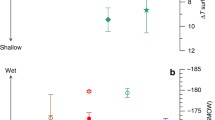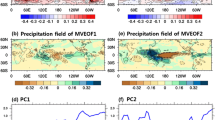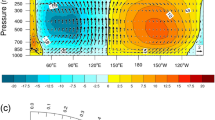Abstract
Recent studies indicate a weakening of the Walker Circulation during the twentieth century. Here, we present evidence from an atmospheric general circulation model (AGCM) forced by the history of observed sea surface temperature (SST) that the Walker Circulation may have intensified rather than weakened. Observed Equatorial Indo-Pacific Sector SST since 1870 exhibited a zonally asymmetric evolution: While the eastern part of the Equatorial Pacific showed only a weak warming, or even cooling in one SST dataset, the western part and the Equatorial Indian Ocean exhibited a rather strong warming. This has resulted in an increase of the SST gradient between the Maritime Continent and the eastern part of the Equatorial Pacific, one driving force of the Walker Circulation. The ensemble experiments with the AGCM, with and without time-varying external forcing, suggest that the enhancement of the SST gradient drove an anomalous atmospheric circulation, with an enhancement of both Walker and Hadley Circulation. Anomalously strong precipitation is simulated over the Indian Ocean and anomalously weak precipitation over the western Pacific, with corresponding changes in the surface wind pattern. Some sensitivity to the forcing SST, however, is noticed. The analysis of twentieth century integrations with global climate models driven with observed radiative forcing obtained from the Coupled Model Intercomparison Project (CMIP) database support the link between the SST gradient and Walker Circulation strength. Furthermore, control integrations with the CMIP models indicate the existence of strong internal variability on centennial timescales. The results suggest that a radiatively forced signal in the Walker Circulation during the twentieth century may have been too weak to be detectable.













Similar content being viewed by others
References
Allan R, Ansell T (2006) A new globally complete monthly historical gridded mean sea level pressure dataset (HadSLP2): 1850–2004. J Clim 19:5816–5842
Bunge L, Clarke AJ (2009) A verified estimation of the El Niño index Niño-3.4 since 1877. J Clim 22:3979–3992
Cane MM, Clement AC, Kaplan A, Kushnir Y, Pozdnyakov D, Seager R, Zebiak SE, Murtugudde R (1997) Twentieth-century sea surface temperature trends. Science 275:957–960
Clarke AJ, Lebedev A (1996) Interannual and decadal changes in equatorial wind stress in the Atlantic, Indian, and Pacific Oceans and the Eastern Ocean coastal response. J Clim 10:1722–1729
Clement AC, Seager R, Cane MA, Zebiak SE (1996) An ocean dynamical thermostat. J Clim 9:2190–2196
Copsey D, Sutton R, Knight JR (2006) Recent trends in sea level pressure in the Indian Ocean region. Geophys Res Lett 33:L19712. doi:10.1029/2006GL027175
Dai A, Fung IY, Del Genio AD (1997) Surface observed global land precipitation variations during 1900–1988. J Clim 10:2943–2962
Deser C, Phillips AS, Alexander MA (2010) Twentieth century tropical sea surface temperature trends revisited. Geophys Res Lett 37:L10701. doi:10.1029/2010GL043321
DiNezio P, Clement A, Vecchi GA (2010) Reconciling differing views of tropical pacific climate change. EOS 91:141–142
Guan B, Nigam S (2008) Pacific sea surface temperatures in the twentieth century: an evolution-centric analysis of variability and trend. J Clim 21:2790–2809
Hasselmann K (1976) Stochastic climate models part I. Theory. Tellus 28:473–485
Hasselmann K (1988) PIPs and POPs: the reduction of complex dynamical systems using principal interaction and principal oscillation patterns. J Geophys Res 93:11015–11021
Held IM, Soden BJ (2006) Robust responses of the hydrological cycle to global warming. J Clim 19:5686–5699
IPCC (2007) Climate change 2007: the physical science basis. Contribution of working group I to the fourth assessment report of the intergovernmental panel on climate change. Cambridge University Press, Cambridge
Kalnay E, Kanamitsu M, Kistler R, Collins W, Deaven D, Gandin L, Iredell M, Saha S, White G, Woollen J, Zhu Y, Leetmaa A, Reynolds B, Chelliah M, Ebisuzaki W, Higgins W, Janowiak J, Mo K, Ropelewski C, Wang J, Jenne R, Joseph D (1996) The NCEP/NCAR 40-year reanalysis project. Bull Am Meteorol Soc 77:437–471
Karnauskas K, Seager R, Kaplan A, Kushnir Y, Cane M (2009) Observed strengthening of the zonal sea surface temperature gradient across the equatorial Pacific Ocean. J Clim 22:4316–4321
Latif M, Keenlyside N (2009) El Niño/Southern Oscillation response to global warming. Proc Natl Acad Sci. doi:10.1073/pnas.0710860105
Latif M, Keenlyside N, Bader J (2007) Tropical sea surface temperature, vertical wind shear, and hurricane development. Geophys Res Lett 34:L01710. doi:10.1029/2006GL027969
Meehl GA, Washington WM (1996) El Niño-like climate change in a model with increased atmospheric CO2 concentrations. Nature 382:56–60
Meehl GA, Arblaster JM, Branstator G, van Loon H (2008) A coupled air–sea response mechanism to solar forcing in the pacific region. J Clim 21:2883–2897
Mitchell TD, Jones PD (2005) An improved method of constructing a database of monthly climate observations and associated high-resolution grids. Int J Climatol 25:693–712
Power SB, Smith IN (2007) Weakening of the Walker Circulation and apparent dominance of El Niño both reach record levels, but has ENSO really changed? Geophys Res Lett 34:L18702. doi:10.1029/2007GL030854
Rayner NA, Brohan P, Parker DE, Folland CK, Kennedy JJ, Vanicek M, Ansell TJ, Tett SFB (2006) Improved analyses of changes and uncertainties in sea surface temperature measured in situ since the mid-nineteenth century: the HadSST2 dataset. J Clim 19:446–469
Roeckner E et al (2003) The atmospheric general circulation model ECHAM5, part I: model description. Technical report 349, MPI, Hamburg
Schneider EK, Fan M (2007) Weather noise forcing of surface climate variability. J Atmos Sci 64:3265–3280
Smith TM, Reynolds RW, Peterson TC, Lawrimore J (2008) Improvements to NOAA’s historical merged land-ocean surface temperature analysis (1880–2006). J Clim 21:2283–2296
Sohn BJ, Park S-C (2010) Strengthened tropical circulations in past three decades inferred from water vapor transport. J Geophys Res 115:D15112. doi:10.1029/2009JD013713
Storch H, Bruns T, Fischer-Bruns I, Hasselmann K (1988) Principal oscillation pattern analysis of the 30–60-day oscillation in a general circulation model equatorial troposphere. J Geophys Res 93:11022–11036
Vecchi GA, Clement A, Soden BJ (2008) Examining the tropical pacific’s response to global warming. EOS Trans Am Geophys Union 89(9):81, 83
Vecchi GA et al (2006) Weakening of tropical pacific atmospheric circulation due to anthropogenic forcing. Nature 441. doi:10.1038/nature04744
Xue Y, Smith TM, Reynolds RW (2003) Interdecadal changes of 30-yr SST normals during 1871–2000. J Clim 16:1601–1612
Zhang M, Song H (2006) Evidence of deceleration of atmospheric vertical overturning circulation over the tropical pacific. Geophys Res Lett 33:L12701. doi:10.1029/2006GL025942
Acknowledgments
This work was supported by the DFG-supported project SFB 754 (www.sfb754.de), the TROIA Project of the Deutsche Forschungsgemeinschaft, and by the European Project ENSEMBLES. Qingjia Meng was supported by the China Scholarship Council. The model runs were performed at the North-German Supercomputing Alliance (HLRN). This is a contribution to the Excellence Cluster “The Future Ocean” (www.ozean-der-zukunft.de).
Author information
Authors and Affiliations
Corresponding author
Rights and permissions
About this article
Cite this article
Meng, Q., Latif, M., Park, W. et al. Twentieth century Walker Circulation change: data analysis and model experiments. Clim Dyn 38, 1757–1773 (2012). https://doi.org/10.1007/s00382-011-1047-8
Received:
Accepted:
Published:
Issue Date:
DOI: https://doi.org/10.1007/s00382-011-1047-8




